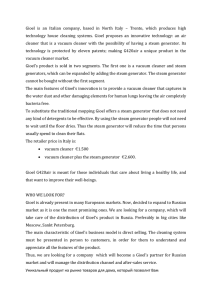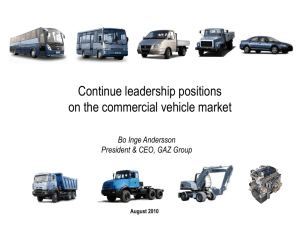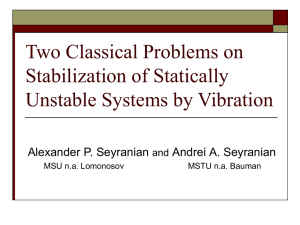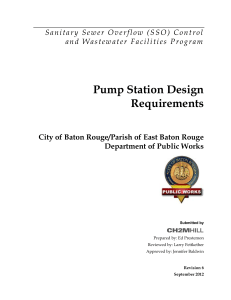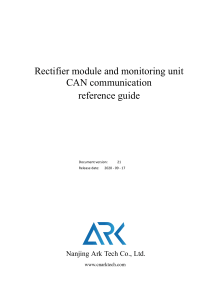
Available online at www.sciencedirect.com ScienceDirect Procedia Engineering 187 (2017) 272 – 280 10th International Scientific Conference Transbaltica 2017: Transportation Science and Technology Modernization of Diesel-electric Locomotive 2M62 and TEP-70 Locomotives with Respect to Electrical Subsystem Lionginas Liudvinavičiusa,*, Virgilijus Jastremskasb a Department of Railway Transport, Vilnius Gediminas Technical University, Lithuania b JSC “Lithuanian Railways”, Vilnius, Lithuania Abstract In article analysing typical electrical locomotives were manufactured with analogous control systems (2M62, TEP-70) of the entire power train and electric drive, which have a lot of deficiencies. The major deficiency was high fuel consumption. The locomotive traction force Fk = f(v) for the theoretical traction requirements must be inversely proportional to the movement speed v. This characteristics is called hyperbole, it allows optimum control of the locomotive in the entire speed range, i.e. to use the diesel engine power to its full extent. Once such locomotive traction characteristics are created, the diesel engine capacity in the hyperbole characteristics is constant. To solve this task the traction characteristics Fk = f(v) and traction generator load characteristics Ug = f(Ig) must be hyperbolic shape. In order to improve energy characteristics of diesel-electric locomotives 2M62, TEP-70, analysis of their automatic control systems was performed. Based on this, the systems which were proposed by the authors and implemented, have enabled significant reduction of fuel consumption, improved driver’s working conditions, traffic safety, etc. Especially important technical tasks to be solved were to improve general reliability of locomotives, and to reduce operation costs. The authors have proposed not to use special electric machines for excitation of traction generators, but to replace them with contactless semiconductor static converters and to use microprocessor based locomotive parameters control systems. © 2017 2017The TheAuthors. Authors. Published by Elsevier Ltd.is an open access article under the CC BY-NC-ND license © Published by Elsevier Ltd. This Peer-review under responsibility of the organizing committee of the 10th International Scientific Conference Transbaltica 2017: (http://creativecommons.org/licenses/by-nc-nd/4.0/). Transportation and Technology. Peer-review underScience responsibility of the organizing committee of the 10th International Scientific Conference Transbaltica 2017 Keywords: diesel-electric locomotive, traction generator, static converter, traction generator’s load characteristic, microprocessor (computer) control * Corresponding author. E-mail address: lionginas.liudvinavicius@vgtu.lt 1877-7058 © 2017 The Authors. Published by Elsevier Ltd. This is an open access article under the CC BY-NC-ND license (http://creativecommons.org/licenses/by-nc-nd/4.0/). Peer-review under responsibility of the organizing committee of the 10th International Scientific Conference Transbaltica 2017 doi:10.1016/j.proeng.2017.04.375 Lionginas Liudvinavičius and Virgilijus Jastremskas / Procedia Engineering 187 (2017) 272 – 280 1. Introduction Electrical locomotives made in Russia, Czechoslovakia, Ukraine have been mostly used in the railways of the Former Soviet Union. Russian companies have manufactured diesel-electric passenger locomotives –TEP-60, TEP70, freight locomotives 2M62 were manufactured in Ukraine. “Lietuvos geležinkeliai AB”, owning fleet of typical freight locomotives 2M62, and passenger locomotives TEP70, has decided to upgrade them. To this end, “Lietuvos geležinkeliai AB” has established subsidiary company Vilniaus lokomotyvų remonto depas UAB, where locomotives were upgraded and the new locomotives were manufactured for LG and abroad railways within the period of 2005–2015. Upgrade of locomotives in Vilniaus lokomotyvų remonto depas UAB was performed together with scientists of Vilnius Gediminas Technical University and “Lietuvos geležinkeliai AB”. The locomotives were upgraded with participation of “Lietuvos geležinkeliai AB” subsidiary Vilniaus lokomotyvų remonto depas UAB, CJSC TMHB Transmashholding, Caterpillar, MTU, Hungarian company “Woodward-Mega Kft” and others. In Poland freight locomotives 2M62 was named as ST44. Freight locomotives ST44 in Poland were modernized and equipped with modern sets and devices. ST44 locomotives were completely rebuilt by Bumar-Fablok S. A. and delivered to the line. Changes made included new Caterpillar 3516B HD diesel engines and primary alternators. 2. Modernization aspects of diesel-electric locomotive series 2M62 (ST 44) 2.1. DC/DC diesel-electric locomotive 2M62 automatic control system ACS Analog ACS with magnetic amplifier applied in control systems of diesel-electric locomotives TE10, 3TE10M, TE10M, 2TE10B, 2TE10L, TEP-60, M62, 2M62 [4−8]. Fig. 1. ACS of DC/DC typical diesel-electric locomotive 2M62 traction generator, when low power single-phase AC generator E is used and magnetic amplifier MA is used for processing of control signals: LD – locomotive drive controller; nD – diesel engine crankshaft speed; TG – DC traction generator; EG – exciter; M1-M6 – direct current traction motors; 1-6 – direct current traction motors excitation winding; BV – DC traction generator voltage sensor; SB – selective block; TB – tacho block; NG – DC traction generator separately excitation winding; PS – diesel engine power sensor; CS – current sensors; ΔnD ‒ diesel engine crankshaft speed deviation signal; ΔUg ‒ DC traction generator voltage Ug deviation signals; ΔIg ‒ DC traction generator current Ig deviations signal; MA – magnetic amplifier; EG1 – exciter EG excitation windings; ΔND – diesel engine power deviations signal; Y – control signal. Typical DC/DC diesel-electric locomotive 2M62 traction generator, when low power single-phase AC generator E is used and magnetic amplifier MA is used for control signal processing is shown in Fig. 1. Two low power electric power machines AC auxiliary generator E and exciter EG operating in generator mode are used to control traction generator TG. 2.2. Automatic control and diagnostic system of diesel-electric locomotive series 2M62 Block diagram of computer control [1–3, 9] and diagnostics of power assembly of AC/DC modernized dieselelectric locomotive 2M62 are provided in Fig. 2. 273 274 Lionginas Liudvinavičius and Virgilijus Jastremskas / Procedia Engineering 187 (2017) 272 – 280 Fig. 2. Block diagram of computer control and diagnostics of power assembly of AC/DC modernized diesel-electric locomotive 2M62: A – AC traction generator; UR1-UR6 – traction rectifiers; M1-M6 – direct current traction motors; BV1-BV6 –rectified voltage sensors; CS1-CS6 – current sensors; BR– crankshaft speed sensor; ΔUd ‒ rectified voltage Ud deviation signals; Ud – rectified voltage. A/D – analog-digital converter; D/A – digital-analog converter; ΔId ‒ rectified current Id deviations signal; ΔIE ‒ AC traction generator excitation current IE deviations signal; IB – indicating block; R1, R2 – resistors. Diesel-electric locomotive series 2M62 for heavy cargo trans. Available for 1435/1520 mm gauge with maximum speed up to 100 km/h. Year of beginning of modernization 2005. Delivered number: 58 units. Delivery countries Lithuania, Latvia. The main technical characteristics of diesel-electric locomotive 2M62 before and after modernization are provided in Table 1. Table 1. The main technical characteristics of diesel-electric locomotive 2M62 before and after modernization and photo of modernized dieselelectric locomotive 2M62. Title 2M62 before modernization 2M62 after modernization Wheel-sets arrangement Co’-Co’ Co’-Co’ Rated power, kW 1472 1700 Wheel gauge, mm 1435/1520 1435/1520 Maximal speed, km/h 100 100 Weights, tons 116.5 (±3%) 120 (±3%) Load on axle, tons 19.3 (±3%) 20 (±3%) Minimum curve radius, m 80 80 Diesel engine type Kolomna 14D40 CAT3512 Traction alternator GP312 DSG 86 M14/AVK SEG Power transmission DC/DC AC/DC Auxiliary transmission Hydrostatic Hydrostatic Traction effort of coupling, kN 314 379.5 Control circuit voltage, V 75 24 Traction generator excitation automatic control Using specific electric machines Using only static converter Modernized diesel-electric locomotive 2M62 is a 120 t weight locomotive with six drive axis with the main axis formula Co’-Co’, axial load of rails – 20 t. Locomotive is equipped with “Caterpillar“ diesel engines 1700 kW (CAT Lionginas Liudvinavičius and Virgilijus Jastremskas / Procedia Engineering 187 (2017) 272 – 280 275 3512). These diesel-electric locomotives 2M62M are equipped with typical bogies with six traction motors of DC serial excitation, type ED 118AU1. The main power source in diesel-electric locomotive 2M62M is a power train, which includes diesel engine-generator DSG 86 M1-4/AVK SEG. Diesel engines CAT 3512 and AC traction generators DSG 86 M1-4/AVK SEG are rigidly connected by elastic coupling. Drivers cabin is provided for locomotive control. Microprocessor system controls start-up of diesel engine, prevents power increase up to critical values, limits it in case of overloading. All diesel engine parameters are controlled, diesel engine is stopped in case of overloading up to critical values. Assemblies of diesel electric locomotive 2M62 are arranged so that axial rail loads would not differ more than 3%. Further are installed: cooling unit of internal combustion engine, compressor and its cooler for auxiliary equipment, cabinet of electric equipment, cooling fan of first bogie traction motors, coolant reservoir, internal combustion engine. Diesel engine installed in the common frame of diesel electric locomotive 2M62 is rigidly connected to AC traction generator and exciter G2 [10]. At the back side, high voltage chamber is installed with power circuit electrical devices: start-up circuit contactors, traction motor reversing equipment. Driver’s cabin is provided for locomotive control. 3. Modernization aspects of diesel-electric locomotive series TEP-70 Modernization of AC/DC diesel-electric locomotive TEP-70 used for traction of passenger cars was completed in 2015, in “VLRD UAB“, subsidiary of “Lietuvos geležinkeliai AB“ with participation of TMHB and Hungarian company “Woodward-Mega Kft“. During design phase of modernization, authors have assessed how locomotive dynamic properties are influenced by axial load variation of drive wheelsets. The authors analyzed the typical AC/DC power system locomotive TEP-70 traction generator automatic control system ACS. Typical diesel electric generators and have established that a load characteristic of traction generators is not of hyperbolic shape. Due to this, significant part of transformed diesel engine power is lost. Better results can be obtained by using microprocessor (computer) control systems for traction generator ACS [1–3]. 3.1. Typical AC/DC diesel-electric locomotive TEP-70 automatic control system ACS Analogue automatic control system ACS system of AC traction generator is used in typical diesel-electric locomotives TEP-70 produced in Russia. Shaped (artificial) traction generator load characteristics Ug = (f)Ig, using the controlled rectifier – approached to the hyperbole shape (see Fig. 3). Fig. 3. ACS diagram of AC/DC diesel-electric locomotive TEP-70 traction generator, when controlled rectifier CR is used: DM – diesel engine; TG – AC traction generator; NG– AC traction generator separately excitation windings; UR – uncontrolled traction rectifier; E – low-power single-phase generator; CR – controlled rectifier; M1-M6 – direct current traction motors; 1-6 – direct current traction motors M1-M6 excitation windings; LD – locomotive drive controller; SB – selective block; BV – rectified voltage sensor; CS – current sensors; ΔUd ‒ rectified voltage Ud deviation signals; ΔIg ‒ DC traction generator current Ig deviations signal; E–low-power single-phase generator excitation windings; Udα – thyristors rectified voltage; A – low-power single-phase generator part; B – traction generator TG part. 276 Lionginas Liudvinavičius and Virgilijus Jastremskas / Procedia Engineering 187 (2017) 272 – 280 ACS diagram of AC/DC diesel-electric locomotive TEP-70 traction generator, when static converter (controlled rectifier CR) (a) is used and time diagrams is provided in Fig. 4. Controlled rectifier CR is used for traction generator excitation current control (see Fig. 4a). a) b) Fig. 4. ACS diagram of AC/DC diesel-electric locomotive TEP-70 traction generator, when static converter (controlled rectifier CR) (a) is used, and time diagrams (b): G – synchronous traction generator; E – low-power single-phase generator; IE – traction generator excitation current; CR – controlled rectifier; D1, D2 – diodes, S1, S2– thyristors; Udα – thyristors rectified voltage; ic – thyristors control signal; T – pulse period; it – IGBT transistors current. Fig. 4 b and (1)–(3) formulas shows traction generator excitation current control time process. Only one low power electric machine is used to control traction generator TG – single-phase AC generator. Load characteristics of traction generator Ug = (f)Ig is shaped by changing thyristor control angle α in rectifier CR. By changing the thyristoric control angle α the thyristors may be opened by corresponding time moments and the total duration may be changed, during which the thyristor releases the current, and in this way a smooth regulation of the average rectified voltage value. By increasing the opening angle α of the thyristor, the thyristor is opened later and later, therefore, the average rectified voltage Uavrg will be smaller. By increasing the control angle α of the thyristors, the curves of the rectified voltage are reduced and the abscissa load is restricted as well as the average rectified voltage Uavrg. The greatest value of the rectified average voltage Uavrg. are reached when α = 0, and equals zero, when α = 180°. With active load, the value of the rectified voltage is calculated as follows [11]: U dα = 1α 2 2 1 + cosα U2 , 2U 2sinω tdω t = ∫ π0 π 2 (1) here: U2 is the effective value of the source voltage. The effective value of the load current is calculated as follows: I dα = I da π−α , π (2) here: Ida is the effective value of the load current, where α = 0. The average current value of the thyristors S1, S2 and diodes D1, D2 is calculated as follows: 277 Lionginas Liudvinavičius and Virgilijus Jastremskas / Procedia Engineering 187 (2017) 272 – 280 IT = π−α I da . 2π (3) ACS diagram of typical AC/DC diesel-electric locomotive TEP-70 traction generator, when controlled rectifier CR is used is provided in Fig. 5. Shaped (artificial) traction generator load characteristics Ug = (f)Ig, using the controlled rectifier – approached to the hyperbole shape (see Fig. 5). Fig. 5. ACS diagram of AC/DC diesel-electric locomotive TEP-70 traction generator, when controlled rectifier CR is used: TG – AC traction generator; UR – traction rectifier; E – low-power single-phase generator; CR – controlled rectifier; M1-M6 – direct current traction motors; BV –rectified voltage sensor; CS – current sensors; ΔUd ‒ rectified voltage Ud deviation signals; ΔIg ‒ DC traction generator current Ig deviations signal; E – low-power single-phase generator excitation windings; Udα – thyristors rectified voltage. A – low-power single-phase generator part; B – traction generator TG part. 3.2. Automatic control and diagnostic system of upgraded diesel - electric locomotive TEP-70 The main purpose of the upgraded diesel-electric locomotive TEP-70 series with electric drive is traction of passenger cars. Maximum speed of the upgraded diesel-electric locomotive TEP-70 is 160 km/h. Driver cabins are installed in the back part of the locomotive. The upgraded diesel-electric locomotive TEP-70 is equipped with computer (microprocessor) control system for automated control of the diesel engine generator and power assembly. The upgraded diesel-electric locomotive TEP-70 is of weight 126 t and has six driving axles, with axis formula – C0’-C0’. The locomotive is equipped with the “MTU” 20 cylinder 4000 AG capacity diesel engine. Typical dieselelectric locomotive bogies of Russian production are used, in which six DC serial excitation traction motors ED 121AU1 of 324 kW capacity are installed. The main power source in the diesel-electric locomotive TEP-70 is the power assembly consisting of diesel engine and two AC generators: traction and auxiliary. Diesel engines and AC generators are rigidly connected with elastic coupling. By authors developed and implemented the block diagram of computer control and diagnostics of the upgraded diesel-electric locomotive TEP-70M is provided in Fig. 6. Important part of the diesel engine generator also is the auxiliary AC generator of 700 kVA capacity intended for the locomotive’s board three-phase network 3 × 400 V, 50 Hz, as well as, for heating of passenger cars. AC traction generator of 2900 kVA capacity is the power source supplying the electrical traction system. Static convertersregulators [12, 13] are used for excitation of generators. Irrespectively of the main locomotive computer control system, diesel engine parameters are monitored and controlled by the autonomous electronic control system designed by company “MTU”. Authors have analyzed ACS of traction generators of typical diesel-electric locomotives 2M62, TEP-70 and proposed to use semiconductor static converters for excitation of traction generators [13–15] in the upgraded LG diesel-electric locomotives. To ensure optimal use of diesel engine capacity in the entire speed range, traction generator load characteristics Ug = (f)Ig shape must be the same as that of traction characteristics F = (f)v [16, 17]. Typical AC/DC diesel-electric locomotive TEP-70 traction generator load characteristics before modernization (a) [18] and traction generator load characteristics of the upgraded diesel-electric locomotive TEP-70M (b) are provided in Fig. 7. 278 Lionginas Liudvinavičius and Virgilijus Jastremskas / Procedia Engineering 187 (2017) 272 – 280 Fig. 6. The block diagram of computer control and diagnostics of the upgraded diesel-electric locomotive TEP-70M. a) b) Fig. 7. Typical AC/DC diesel-electric locomotive TEP-70 traction generator load characteristics before modernization (a) and traction generator load characteristics of the upgraded diesel-electric locomotive TEP-70M (b). Load characteristics of traction generator ideally should be of hyperbole shape. Characteristics obtained using synchronous traction generator excitation method proposed by the authors are provided in Fig. 7b. 3.3. Main and control equipment of modernized locomotive TEP-70 The main technical data of the upgraded diesel-electric locomotive TEP-70M 0249 is provided in Table 2. After analysis of influence on locomotive dynamics, assemblies of the upgraded diesel-electric locomotive TEP70 are arranged so that axial rail loads would not deviate more than 3%. The diesel engine installed in the center of the common frame of the diesel-electric locomotive TEP-70 is rigidly connected to AC traction, auxiliary equipment supply and passenger car heating generators. Generators for traction, auxiliary equipment supply and passenger car heating and their exciters are installed in a single electric machine. Driver’s cabin is provided for locomotive control. Layout of the main equipment of the upgraded diesel-electric locomotive TEP-70 is shown in Fig. 8. Lionginas Liudvinavičius and Virgilijus Jastremskas / Procedia Engineering 187 (2017) 272 – 280 Table 2. The main technical data of diesel-electric locomotive TEP-70M 0249 before and after modernization. Title TEP-70 before modernization TEP-70 after modernization Maximal speed, km/h 160 160 Wheel gauge, mm 1520 1520 Weights, tons 135 t (±3%) 133 t (±3%) Load on axle, tons 21 t 22.2 t (±3%) Wheel-sets arrangement C’0-C’0 C’0-C’0 Diesel engine type 2А-5D49 – diesel engine-generator type MTU20V4000R43L Rated engine power, kW 2942 3000 Traction alternator GS504 1TAG-2900/700-TEP70 Traction alternator rated power, kW 2750 2900 Minimum curve radius, m 125 125 Power transmission AC/DC AC/DC Wagon heating power – 400 kW Traction generator excitation automatic control Using specific electric machine with static converter Using only static converter Auxiliary transmission Hydrostatic Auxiliary systems driven by AC motors Fig. 8. Layout of the main equipment of the upgraded diesel-electric locomotive TEP-70: 1 – diesel engine cooling equipment; 2 – cooling fan of traction motors of the first bogie; 3 – MTU internal combustion engine; 4 – AC traction generator and AC exciting generator (one electric machine) and 3-phase bridge rectifier; 5 – passenger coaches heating equipment; 6 – cooling fan of traction motors of the second bogie; 7 – compressor; 8 – battery compartment; VZA-A and VZA-B – control panels; KVZ70 – central cabinet of equipment. The following assemblies and equipment are arranged in the upgraded diesel-electric locomotive TEP-70: Central cabinet of equipment KVZ70, auxiliary equipment control cabinet, passengers coaches heating rectifier, control panel VZA-A, control panel VZA-B, electrical cabinet; machinery compartment cabinet; battery compartment, MTU internal combustion engine, battery charging generator and two starters, AC traction generator and AC exciting generator (one electric machine) and 3-phase bridge rectifier, auxiliary equipment and passenger coaches heating system supply, AC generator and AC exciting generator (one electric machine), compressor, cooling fan of traction motors of the first bogie, cooling fan of traction motors of the second bogie. 279 280 Lionginas Liudvinavičius and Virgilijus Jastremskas / Procedia Engineering 187 (2017) 272 – 280 4. Conclusions 1. Traction generator excitation control system proposed by the authors enabled approach of the artificial load characteristics to hyperbolic nature; ICE power is fully used in the entire speed range; 2. Traction generator’s artificial load characteristics are stable. Traction generator’s artificial load characteristics parts of maximum current restriction and hyperbolic nature were shaped in ACS; 3. Traction generator excitation system (contactless, without moving parts) has become more reliable, it does not contain the electric machine intended for excitation, which are driven by a diesel engine in typical arrangements; 4. Contactless components are used in the static converter – controlled semi-conductors – thyristors or IGBT transistors; 5. Traction generator’s excitation system is long-life; 6. The static converter has enabled significant reduction traction generator’s control power; 7. After modernization of LG freight locomotives, fuel consumption was reduced up to 25% according to Statistical Department Of Lithuanian Railways; 8. Fuel consumption of the upgraded diesel-electric locomotive TEP-70M decreased by 20% according to Statistical Department Of Lithuanian Railways; 9. The upgraded diesel-electric locomotive TEP-70M can heat reliably 8−10 pcs. of passenger cars; 10. The implemented diagnostics systems enable prompt elimination of complex faults. References [1] S. Östlund, Electric Railway traction. KTH, Stockholm, Sweeden. 2011. [2] V. V. Strekopytov, A. В. Grishchenko, V. A. Kruchek, Electric drives of the locomotives. (In Russian) Moscow: Marshrut. 2003. 305 p. [3] L. Liudvinavičius, S. Dailydka, G. Vaičiūnas, Traction energy system and their control. Coursebook. (In Lithuanian) Vilnius: Technika. 2015. 616 p. ISBN 978-609-457-791-8. [4] E. E. Kossov, S. I. Sukhoparov, Optimization of operating modes of diesel generators. (In Russian) M.: Intekst. 1999. 184 p. [5] V. K. Kalinin, Electric locomotives and electric trains. (In Russian) Moscow: Transport. 1991. [6] N. I. Volkov, V. P. Milovzorov, Electric machinery automation. (In Russian) Moscow: Higher School. 1978. 336 p. [7] F. M. Yuferov, Electric machines automatic devices. (In Russian) Moscow: Higher School. 1976. 416 p. [8] C. P. Filonov et al., Diesel locomotive 2TE116. (In Russian) M.: Transport. 1996. 335 p. [9] K. Fuest, P. Döring, Elektrische Maschine und Antriebe. Lehr- und Arbeitsbuch. Vieweg. Wiesbaden. 2000. [10] D. Jolevski, Excitation System of Synchronous Generator. University of Split, Faculty of Electrical Engineering, Mechanical Engineering and Naval Arhitecture, Split. 2009. [11] L. Liudvinavičius, L. P. Lingaitis, S. Dailydka, Traction rolling stock power drives and their control: common high school text book. (In Lithuanian) Vilnius: Technika. 2010. 320 p. ISBN 978-9955-28-559-5. [12] G. R. Slemon, Electric Machines and Drives. Addison-Wesley Publ. Comp. 1992. ISBN 0-201-57885-9. [13] J. Machowski, J. W. Bialek, S. Robak, J. R. Bumby, Excitation control system for use with synchronous generators. IEE Proc.- Gener. Transm. Distrib. 145(5) (September 1998). [14] D. Sumina, G. Erceg, T. Idžotić, Excitation control of a synchronous generator using fuzzy logic stabilizing controller. EPE 2005 – Dresden. 2005. [15] T. Bodefeld, H. Sequenz, Electrical Machinery. Springer. 1981. [16] L. Liudvinavičius, L. P. Lingaitis, Locomotive energy savings possibilities, Transport problems: International Scientific Journal Part 1. 4(3) 35–41. ISSN 1896-0596. Gliwice. 2009. [17] M. Miskovic, M. Mirosevic M. Milkovic, Analysis of Synchronous Generator Angular Stability depending on the Choise of the Excitation System. Energija 58(4) 430–445. INSPEC. 2009. [18] V. G. Bykov, B. N. Moroshkin, G. E. Serdelevich, J. V. Chlebnikov, V. M. Shiriajev, Passenger locomotive TEP-70. (In Russian) M.: Transport. 1976. 232 p.
